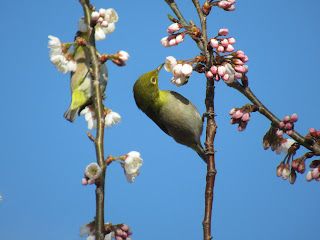Spring has come, no matter what COVID-19 is doing for our community. Although the City of Yokohama is not yet under lockdown, the Governor of Kanagawa Prefecture is asking us self-restraint to go out except for absolute necessity. Schools enter spring recess after 2 weeks of closure. People are telecommuting ... The saving grace is our parks and gardens are not yet closed off. And as every spring in Japan, we are now in the season of cherry blossoms. Having said that, this year’s flowers are somewhat strange.
 |
| Cerasus ×yedoensis (Matsum.) Masam. & Suzuki 'Somei-yoshino' |
Local Meteorological
Agencies in Japan declare opening of cherry blossoms for their prefecture when
more than 5 buds open in the benchmark tree. People are eager to know when it would be. So,
the Agency forecasts the arrival of the flowers. They have complicated formula
to deliver the date based on scientific studies by botanists (; we can find
related academic articles here). The abbreviated version of this math is to
calculate the sum of average daily temperature from February 1st. The
benchmark is the day when the total becomes more than 400°C for a location. The forecasted date is plus or
minus from the date when the sum reaches to 400. This year in Yokohama, it is
like
8.9*29 +
12.3 + 7.9 + 11.4 + 9.7 + 9.6 + 9.7 + 7.7 + 7.4 + 13.3 + 14.9 + 16.2 + 11.4 +
13.1
= (Average
daily temperature of February 2020 in Yokohama)*(29 days)+(Sum of daily average
until March 13)
= 402.7
 |
| Somei-yoshino in Niiharu this year |
Actually it was March 18th this year when more than 5 flowers were observed in the benchmark tree planted in the campus of Yokohama Meteorological Observatory. This itself was super-early, 8 days earlier than the average of last 30 years. Yeah, we have had very mild winter. No wonder cherries have flowered this quick. But that’s not all.
 |
| Cerasus jamasakura, aka wild cherry |
Normally, cherry blossoms burst into open almost at once. It seems to me, this year it’s not that simple. One part of a branch is fully open, but not the other sections. Trees have jumbles of flowers, half-open blossoms, and still very young buds. When we see them from afar, they are often not a familiar pink clouds, but wispy smokes with lots of holes. Hmmmmmmmmmm … Cherry trees complete forming their buds before winter comes. Then, they sleep under cold weather until an occasional warm spell in February kicks them out of dormancy. Just like we jump out of bed with alarm clocks every morning for morning java, they wake up and burst into the flowery frenzy. But, if winter is not chilly enough … it could be like a morning for us after insomnia. I’ve found an academic bibliography here that discusses this issue. Maybe, this year’s frail blooming is something of global warming …
 |
| A confusion
… I hope it won’t be an epitaph … (Yes, Naomi loves King Crimson!) |
By the way, the forecast date of full-bloom in Yokohama is 27th, i.e. today. Yes, facing COVID-19, we are good boys and girls of self-restraint!
If you find environmental issues in Kanagawa Prefecture, please make a contact with Kanagawa Natural Environment Conservation Center 神奈川県自然環境保全センター
657 Nanasawa, Atsugi City, 243-0121
〒243-0121 厚木市七沢657
Phone: 046-248-0323
You can send an enquiry to them by clicking the bottom line of their homepage at http://www.pref.kanagawa.jp/div/1644/





























